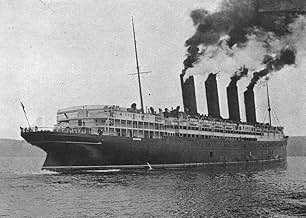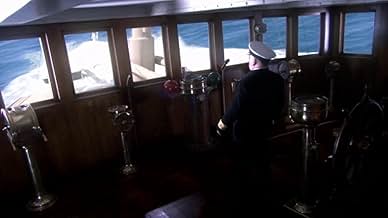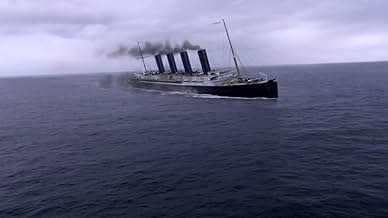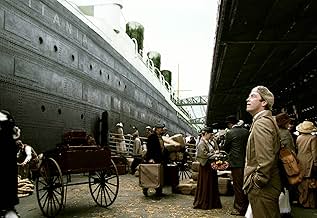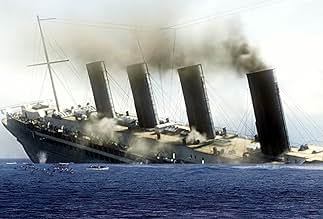Lusitania: Murder on the Atlantic
- Filme para televisão
- 2007
- 1 h 30 min
AVALIAÇÃO DA IMDb
6,9/10
667
SUA AVALIAÇÃO
Adicionar um enredo no seu idiomaA dramatization of the notorious World War I torpedoing of the ocean liner, RMS Lusitania.A dramatization of the notorious World War I torpedoing of the ocean liner, RMS Lusitania.A dramatization of the notorious World War I torpedoing of the ocean liner, RMS Lusitania.
- Direção
- Roteiristas
- Artistas
Florian Panzner
- Lt. Capt. Schwieger
- (as Florian Panzer)
Madeleine Garrood
- Avis Dolphin
- (as Maddeleine Garrood)
Andre Weideman
- Johnston
- (as Andre Weiderman)
Stephen Jennings
- Carson
- (as Steven Jennings)
Robyn LeAnn Scott
- Peggy
- (as Robyn Scott)
- Direção
- Roteiristas
- Elenco e equipe completos
- Produção, bilheteria e muito mais no IMDbPro
Enredo
Você sabia?
- CuriosidadesThe U-20 set was the original U-96 set used in O Barco: Inferno no Mar (1981). The Type U-19 of World War I and Type VIIC of World War II had similar internal dimensions.
- Erros de gravaçãoOn at least two occasions the captain of the U 20 gives the order to "blow ballast" when he wants to dive the submarine. This order would result in all water being blown out of the ballast tanks and should only be given to surface the boat. In order to dive a submarine one must flood the ballast tanks with water.
- Citações
Captain Turner: They're not interested in the truth.
- Cenas durante ou pós-créditosAdrian Topol's character name is pronounced Voegele in the German dialogue and is spelled this way in the accompanying English subtitles. However in the credits it is spelled Vogele. Correct German spelling uses either "ö" (o with an umlaut) or else "oe".
- ConexõesFeatured in Titanic al detalle (2013)
Avaliação em destaque
"Lusitania, murder on the Atlantic" may well be considered as a cheaper version of the 1998-blockbuster "Titanic", starring Kate Winslet and Leonardo DiCaprio. Although the Lusitania-film provides good entertainment, it leads you on false tracks when it comes to history.
The big question with Lusitania, unsolved to this day: the ship was too big to sink with only one torpedo. However, historically it is beyond doubt that she was sunk by just one torpedo. Even more so, after being hit she sank pretty fast.
Every fisherman at Ireland's Southern coast can exactly point out the location of the Lusitania-wreck, about 100 meters down. So the wreck has already been investigated by several diving parties, among them one led by Robert Ballard in 1993. Ballard is the American who discovered the wrecks of the "Titanic", as well as that of Hitler's famous battleship "Bismarck". Ballard thinks that the torpedo hit one of Lusitania's coal-stores, making the coal-dust explode. Carrying this explosion on to neighboring coal-stores. Later on another diving party found considerable quantities of unexploded ammunition inside the Lusitania.
Given its status as a passenger-ship carrying civilians, Lusitania's sinking in May 1915 did the German cause in World War I no good.
The film states that this disaster marked a turning point in the history of warfare, by dropping humanity and chivalry completely. This is wrong: for instance, when the German army invaded Belgium less than a year before, their behavior against defenseless Belgian civilians still evokes horror to this day.
Nevertheless Lusitania's sinking functioned well to win over the USA for their military participation in World War I. In Belgium people do not speak English, so German atrocities over there had been missed by the people of the distant USA.
Another false understanding widely current in the Anglo-Saxon part of the world: in shipping-disasters Lusitania comes only second after Titanic.
Counting in lost human lives, the greatest shipping disaster of all was the torpedoing of the German vessel "Wilhelm Gustloff" by a Soviet-Russian submarine. This happened in January 1945, when the Hitler-vessel carried about 10.000 refugees from Germany's threatened Eastern provinces westwards to safety. Nearly all these people drowned in the icy Baltic Sea, making their number of casualties at least four times as big as that of the Titanic.
The big question with Lusitania, unsolved to this day: the ship was too big to sink with only one torpedo. However, historically it is beyond doubt that she was sunk by just one torpedo. Even more so, after being hit she sank pretty fast.
Every fisherman at Ireland's Southern coast can exactly point out the location of the Lusitania-wreck, about 100 meters down. So the wreck has already been investigated by several diving parties, among them one led by Robert Ballard in 1993. Ballard is the American who discovered the wrecks of the "Titanic", as well as that of Hitler's famous battleship "Bismarck". Ballard thinks that the torpedo hit one of Lusitania's coal-stores, making the coal-dust explode. Carrying this explosion on to neighboring coal-stores. Later on another diving party found considerable quantities of unexploded ammunition inside the Lusitania.
Given its status as a passenger-ship carrying civilians, Lusitania's sinking in May 1915 did the German cause in World War I no good.
The film states that this disaster marked a turning point in the history of warfare, by dropping humanity and chivalry completely. This is wrong: for instance, when the German army invaded Belgium less than a year before, their behavior against defenseless Belgian civilians still evokes horror to this day.
Nevertheless Lusitania's sinking functioned well to win over the USA for their military participation in World War I. In Belgium people do not speak English, so German atrocities over there had been missed by the people of the distant USA.
Another false understanding widely current in the Anglo-Saxon part of the world: in shipping-disasters Lusitania comes only second after Titanic.
Counting in lost human lives, the greatest shipping disaster of all was the torpedoing of the German vessel "Wilhelm Gustloff" by a Soviet-Russian submarine. This happened in January 1945, when the Hitler-vessel carried about 10.000 refugees from Germany's threatened Eastern provinces westwards to safety. Nearly all these people drowned in the icy Baltic Sea, making their number of casualties at least four times as big as that of the Titanic.
- wvisser-leusden
- 11 de jul. de 2009
- Link permanente
Principais escolhas
Faça login para avaliar e ver a lista de recomendações personalizadas
Detalhes
- Data de lançamento
- Países de origem
- Idiomas
- Também conhecido como
- Sinking of the Lusitania: Terror at Sea
- Empresas de produção
- Consulte mais créditos da empresa na IMDbPro
Contribua para esta página
Sugerir uma alteração ou adicionar conteúdo ausente

Principal brecha
By what name was Lusitania: Murder on the Atlantic (2007) officially released in India in English?
Responda
